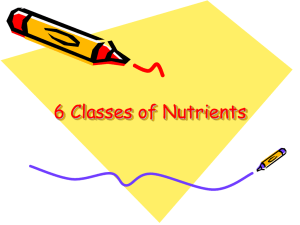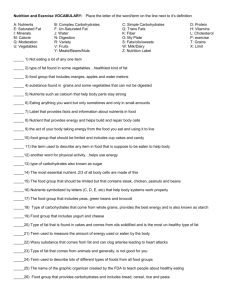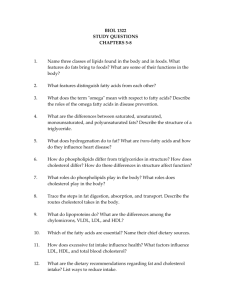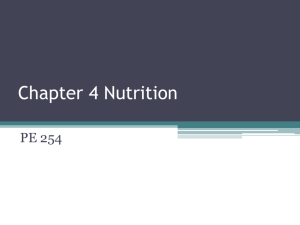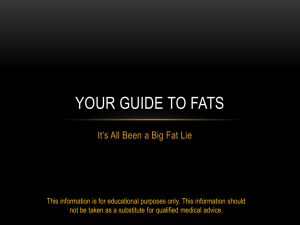Chapter 13 (Nutrition)
advertisement
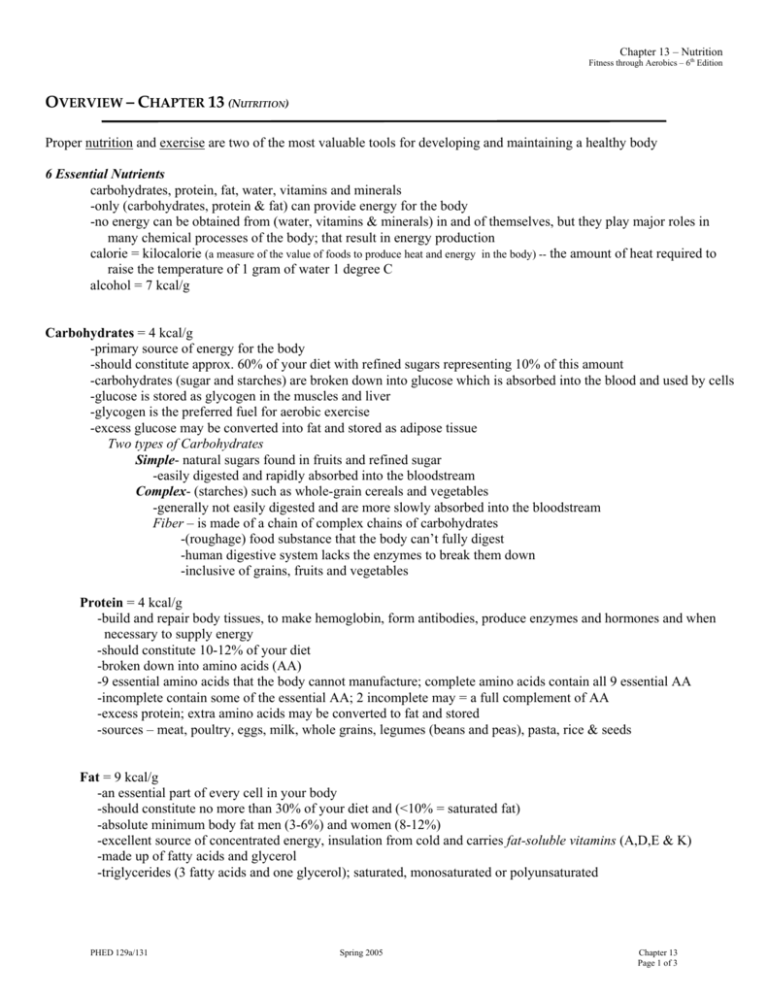
Chapter 13 – Nutrition Fitness through Aerobics – 6th Edition OVERVIEW – CHAPTER 13 (NUTRITION) Proper nutrition and exercise are two of the most valuable tools for developing and maintaining a healthy body 6 Essential Nutrients carbohydrates, protein, fat, water, vitamins and minerals -only (carbohydrates, protein & fat) can provide energy for the body -no energy can be obtained from (water, vitamins & minerals) in and of themselves, but they play major roles in many chemical processes of the body; that result in energy production calorie = kilocalorie (a measure of the value of foods to produce heat and energy in the body) -- the amount of heat required to raise the temperature of 1 gram of water 1 degree C alcohol = 7 kcal/g Carbohydrates = 4 kcal/g -primary source of energy for the body -should constitute approx. 60% of your diet with refined sugars representing 10% of this amount -carbohydrates (sugar and starches) are broken down into glucose which is absorbed into the blood and used by cells -glucose is stored as glycogen in the muscles and liver -glycogen is the preferred fuel for aerobic exercise -excess glucose may be converted into fat and stored as adipose tissue Two types of Carbohydrates Simple- natural sugars found in fruits and refined sugar -easily digested and rapidly absorbed into the bloodstream Complex- (starches) such as whole-grain cereals and vegetables -generally not easily digested and are more slowly absorbed into the bloodstream Fiber – is made of a chain of complex chains of carbohydrates -(roughage) food substance that the body can’t fully digest -human digestive system lacks the enzymes to break them down -inclusive of grains, fruits and vegetables Protein = 4 kcal/g -build and repair body tissues, to make hemoglobin, form antibodies, produce enzymes and hormones and when necessary to supply energy -should constitute 10-12% of your diet -broken down into amino acids (AA) -9 essential amino acids that the body cannot manufacture; complete amino acids contain all 9 essential AA -incomplete contain some of the essential AA; 2 incomplete may = a full complement of AA -excess protein; extra amino acids may be converted to fat and stored -sources – meat, poultry, eggs, milk, whole grains, legumes (beans and peas), pasta, rice & seeds Fat = 9 kcal/g -an essential part of every cell in your body -should constitute no more than 30% of your diet and (<10% = saturated fat) -absolute minimum body fat men (3-6%) and women (8-12%) -excellent source of concentrated energy, insulation from cold and carries fat-soluble vitamins (A,D,E & K) -made up of fatty acids and glycerol -triglycerides (3 fatty acids and one glycerol); saturated, monosaturated or polyunsaturated PHED 129a/131 Spring 2005 Chapter 13 Page 1 of 3 saturated fats – related to elevated blood cholesterol, stroke, and coronary heart disease -generally but not always solids at room temperature -- animal fats, butter, cheese, chocolate, coconut and palm oils unsaturated fats – generally liquids or soft solids at room temperature polyunsaturated fats – oils (corn, soybean, cottonseed, safflower, sesame, and sunflower, fish, some nuts (walnuts, pecans, flaxseed) and most margarines monounsaturated fats – peanut, olive and canola oils; avocados, olives and some nuts (peanuts & cashews) Cholesterol- fatty substance found in the blood and in body tissues -naturally synthesized by the body for the formation of bile salts for fat digestion -transported through the blood via lipoproteins -desirable level of total cholesterol is below 200 milligrams per deciliter (mg/dl) High-density lipoprotein (HDL)- picks up cholesterol from blood/cells to liver to make bile salts -termed the garbage man of the blood; picks up cholesterol and dumps it in the liver -35 mg/dl is considered low and a risk factor for coronary artery disease; 60 mg/dl or greater is consider protective Low-density lipoprotein (LDL)- “Bad” Cholesterol -carries cholesterol and deposits it along the wall of the arteries -fatty deposits (plaque) build up, the arteries become narrow and clogged (atherosclerosis) potentially accompanied by hardening of the arteries (arteriosclerosis) either lead to coronary heart disease -combination of diet and exercise is the best way to control cholesterol levels Water -constitutes 70% of body’s weight -solvent for digestion, waste removal; major component of blood and lubricant found in and around joints/organs -should drink six-eight 8-ounce glasses of water daily for normal activity -you can be dehydrated and not even be thirsty -cold drinks (40-50ºF) leave the stomach more quickly than warm drinks; sugars slow down the rate at which fluids leave the stomach -don’t worry about replacing the electrolytes lost during an aerobic class Vitamins -organic compounds that are essential for the process of releasing energy from food -help to control the growth, maintenance, and repair of body tissues -can not be manufactured by the body, must be obtained from balance diet -large doses of fat soluble vitamins can accumulate over time and cause serious toxic effects -diet provides necessary vitamins; exception -- pregnant women, strict vegetarians, and individuals on low-calorie diets Minerals -inorganic compounds that perform a variety of functions in the body -calcium and phosphorous; supply strength and rigidity in body structures like bones and teeth -iron is critical for the formation of hemoglobin; lack of causes fatigue -balanced diet normally provides adequate amounts of minerals -some minerals like calcium, magnesium and zinc must be taken together to ensure proper absorption and use in body PHED 129a/131 Spring 2005 Chapter 13 Page 2 of 3 Antioxidants - an organic substance that can “neutralize” particles called free radical without becoming a free radical itself -reducing free radicals is believed to reduce/prevent the risk of cancer, heart disease and strokes -Vitamins C, E, A; selenium (a mineral) and phytochemicals are antioxidants -sweet potatoes, carrots, spinach, cantaloupe and mangos are great sources of antioxidants Food Pyramid -KNOW all the SERVINGS and GROUPS of the Food Guide Pyramid -provides an general outline of what to eat each day -- designed by the U.S. Dept. of Health and Human Services Source: U.S. Department of Agriculture/U.S. Department of Health and Human Services, August 1992 http://www.cnpp.usda.gov/index.html PHED 129a/131 Spring 2005 Chapter 13 Page 3 of 3
